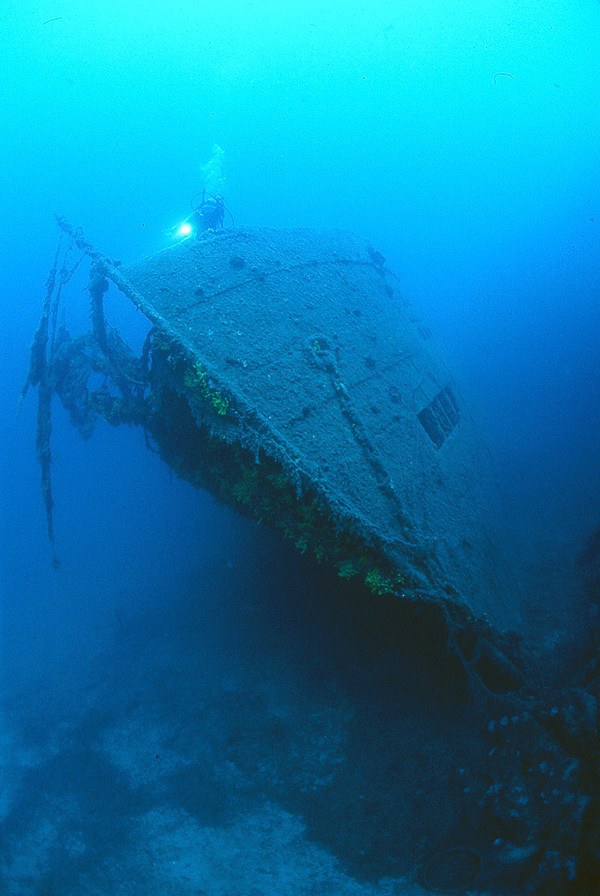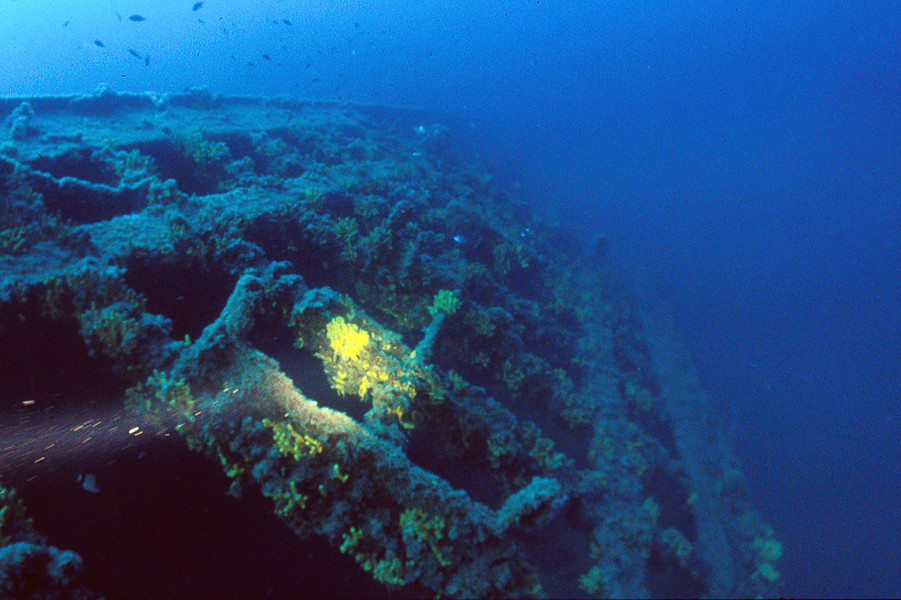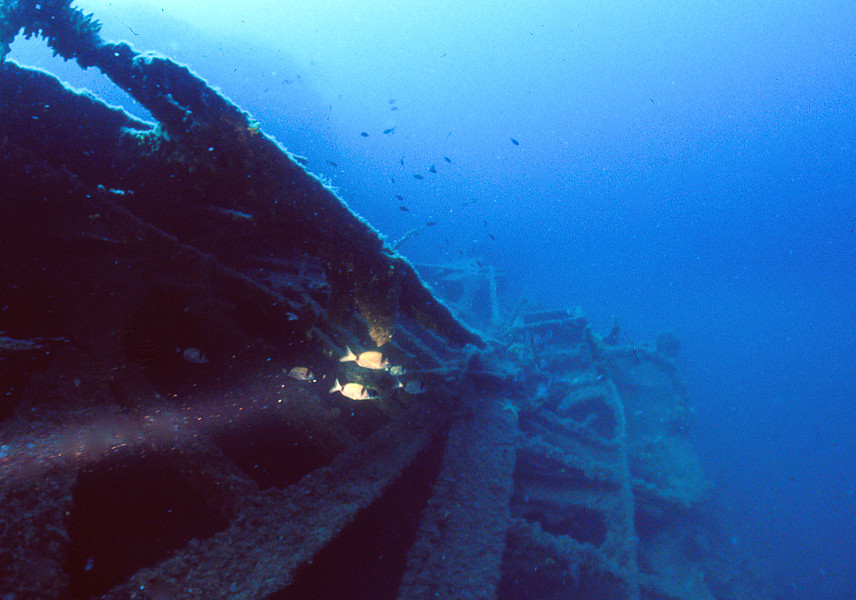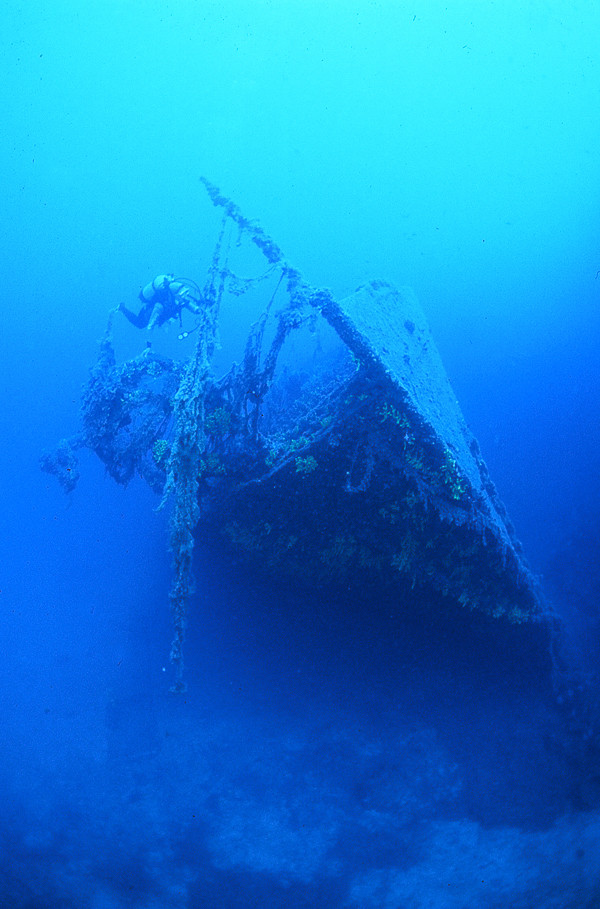
ETNEA
DEPTH: 28 - 35 m
SKILL: Advanced
Etnea (ex-Ernest); cargo steamship; Italy, Societa Etnea Agrumaria company from Catania
Launched: 16th April 1870, W. Doxford & Sons, Pallion, Great Britain
Sunk: 8th November 1894 (navigational error - collision with rocks)
Dimensions: l=61 m, w=8.7 m, 726 tons
Coordinates: 44.63600° N, 14.23057° E
Location: islet of Školjić, island of Unije, opposite the village of Unije
Access: 2/5 access is possible solely by boat (the location is near the rocks opposite the village of Unije)
Visibility: 4/5 good, often excellent
Current: 4/5 mostly weak
Flora and fauna: 4/5 varied life on and around the wreck, occasionally specimens of large fish
HISTORY:
The Etnea was a typical cargo steamship, one of the many which at the beginning of the 20th century sailed along the eastern coast of the Adriatic. It was built way back in 1870 in the shipyard of W. Doxford & Sons in the small town of Pallion in Great Britain under the name of Ernest for the ship owner Fenwick & Co.
In 1889 the Ernest was sold to the British ship owner D.W. Stobart, and then it was sold in the same year to its third owner J. T. Hutchins. Under his flag the Ernest sailed until 1894 when an Italian company the Societa Etnea Agrumaria from Catania bought it to transport agricultural products. However under the Italian flag it did not sail long because at the end of the same year, on 8th November it struck rocks opposite the village of Unije on the island of the same name.
It is interesting that this ship is connected to one of the greatest puzzles with regards to its real identification. Namely, over the past 40 or so years it was believed that it was the wreck of the Austro-Hungarian cargo steamship Tihany which sailed for a number of years for the Ungaro-Croata company along the Adriatic coast, so we presented this wreck as the Tihany in our first book about the wrecks of the Adriatic ‘Secrets of the Adriatic’ which was published in 2002.
WRECK CONDITION AND DIVING:
The steamship Etnea sank alongside the steep north western coast of the islet of Školjić, which is located immediately in front of the settlement of Unije on the island of the same name. It is best to dive along the western shore of Školjić, where the shallow underwater plateau turns into a vertical underwater wall. Already at a depth of ten metres the wreck of the ship, which lies parallel to the coast, can be discerned. The ship is listing severely to starboard, so that its main deck is almost touching the sand on the seabed. Upon descending to the wreck it can be seen that the propeller is missing, which was probably removed during the subsequent rescue attempt. There is not even a trace of the wooden superstructure in the middle of the ship, nor at the stern. At the bow section of the ship the anchor crane and anchor windlass are well-preserved. The anchor chains pass under the bow and disappear under the ship. The masts have collapsed and their parts lie broken over the deck and around the ship. The wooden deck has rotten away, and in its place are the remains of steel cross beam girders which are packed with vivid yellow sponges. Through the cargo hatches it is possible to dive into the ship’s interior which is spacious and bright. In the corners of cargo hold the occasional grouper can also be seen. Over the deck and along the underwater ledge shoals of two-banded breams constantly gather. The central section of the ship is severely damaged, most probably a consequence of the stranding. At the stern section of the ship is located the cargo hatch, and through that can also be reached the aft areas. Along the hatch are very picturesque steam winches which were used for the lifting of cargo with the ship’s cranes.
After visiting the stern section of the ship it is worth descending to the very bottom and extending the dive along the ridge, because ten metres beyond the Etnea are located the traces of an ancient shipwreck with a cargo of amphorae. Although all the amphorae have long since been removed, many necks and other amphora fragments mark the site where some two thousand years ago an ancient ship sank before the steamship Etnea. It is proof that the rocks of Školjić have always presented a danger to navigation. After visiting the ancient shipwreck it is best to return to the lower depths along the underwater wall which is populated by shoals of small fish, to emerge through the underwater canyon at the top of the ridge and thus to finish this beautiful dive.
The description and illustrations are a courtesy of Danijel Frka and Jasen Mesić. Buy the whole book here: https://shop.naklada-val.hr/product_info.php?products_id=561
Launched: 16th April 1870, W. Doxford & Sons, Pallion, Great Britain
Sunk: 8th November 1894 (navigational error - collision with rocks)
Dimensions: l=61 m, w=8.7 m, 726 tons
Coordinates: 44.63600° N, 14.23057° E
Location: islet of Školjić, island of Unije, opposite the village of Unije
Access: 2/5 access is possible solely by boat (the location is near the rocks opposite the village of Unije)
Visibility: 4/5 good, often excellent
Current: 4/5 mostly weak
Flora and fauna: 4/5 varied life on and around the wreck, occasionally specimens of large fish
HISTORY:
The Etnea was a typical cargo steamship, one of the many which at the beginning of the 20th century sailed along the eastern coast of the Adriatic. It was built way back in 1870 in the shipyard of W. Doxford & Sons in the small town of Pallion in Great Britain under the name of Ernest for the ship owner Fenwick & Co.
In 1889 the Ernest was sold to the British ship owner D.W. Stobart, and then it was sold in the same year to its third owner J. T. Hutchins. Under his flag the Ernest sailed until 1894 when an Italian company the Societa Etnea Agrumaria from Catania bought it to transport agricultural products. However under the Italian flag it did not sail long because at the end of the same year, on 8th November it struck rocks opposite the village of Unije on the island of the same name.
It is interesting that this ship is connected to one of the greatest puzzles with regards to its real identification. Namely, over the past 40 or so years it was believed that it was the wreck of the Austro-Hungarian cargo steamship Tihany which sailed for a number of years for the Ungaro-Croata company along the Adriatic coast, so we presented this wreck as the Tihany in our first book about the wrecks of the Adriatic ‘Secrets of the Adriatic’ which was published in 2002.
WRECK CONDITION AND DIVING:
The steamship Etnea sank alongside the steep north western coast of the islet of Školjić, which is located immediately in front of the settlement of Unije on the island of the same name. It is best to dive along the western shore of Školjić, where the shallow underwater plateau turns into a vertical underwater wall. Already at a depth of ten metres the wreck of the ship, which lies parallel to the coast, can be discerned. The ship is listing severely to starboard, so that its main deck is almost touching the sand on the seabed. Upon descending to the wreck it can be seen that the propeller is missing, which was probably removed during the subsequent rescue attempt. There is not even a trace of the wooden superstructure in the middle of the ship, nor at the stern. At the bow section of the ship the anchor crane and anchor windlass are well-preserved. The anchor chains pass under the bow and disappear under the ship. The masts have collapsed and their parts lie broken over the deck and around the ship. The wooden deck has rotten away, and in its place are the remains of steel cross beam girders which are packed with vivid yellow sponges. Through the cargo hatches it is possible to dive into the ship’s interior which is spacious and bright. In the corners of cargo hold the occasional grouper can also be seen. Over the deck and along the underwater ledge shoals of two-banded breams constantly gather. The central section of the ship is severely damaged, most probably a consequence of the stranding. At the stern section of the ship is located the cargo hatch, and through that can also be reached the aft areas. Along the hatch are very picturesque steam winches which were used for the lifting of cargo with the ship’s cranes.
After visiting the stern section of the ship it is worth descending to the very bottom and extending the dive along the ridge, because ten metres beyond the Etnea are located the traces of an ancient shipwreck with a cargo of amphorae. Although all the amphorae have long since been removed, many necks and other amphora fragments mark the site where some two thousand years ago an ancient ship sank before the steamship Etnea. It is proof that the rocks of Školjić have always presented a danger to navigation. After visiting the ancient shipwreck it is best to return to the lower depths along the underwater wall which is populated by shoals of small fish, to emerge through the underwater canyon at the top of the ridge and thus to finish this beautiful dive.
The description and illustrations are a courtesy of Danijel Frka and Jasen Mesić. Buy the whole book here: https://shop.naklada-val.hr/product_info.php?products_id=561








 The investment is co-financed by the Republic of Slovenia and the European Union from the European Regional Development Fund.
The investment is co-financed by the Republic of Slovenia and the European Union from the European Regional Development Fund.  H2O Globe BETA
H2O Globe BETA